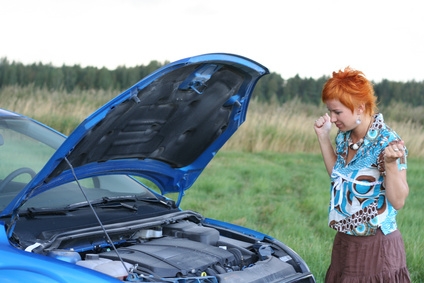
It is critically important to routinely service radiators for several reasons. First, electrolysis will cause mineral deposits to plate on radiator cooling channels, which will ultimately halt coolant flow. In areas with hard water--water with high mineral content--you should avoid using tap water and select factory, premixed coolant for service. Second, rust will inevitably develop and can contaminate the radiator, heater core and thermostat. Third, inefficient radiators cause higher under-hood temperatures.This lowers fuel mileage and shortens engine life.
Jack up the car, place jack stands under the frame and lower the car onto them. Raise the hood and remove the radiator cap. Underneath the car, locate the radiator drain valve. Open the valve and drain the coolant. Use a suitable container to catch the coolant, and close the valve after the coolant has drained.
Remove the thermostat. Follow the upper radiator hose from the radiator to the engine. In most cases the thermostat will be located in a housing attached to this hose. Remove the thermostat and reinstall the housing.
Remove the upper radiator hose and slowly fill the radiator with tap water. Allow water to fill the engine block, and begin to run out the upper radiator outlet. Reinstall the upper hose. Pour a bottle of water-based cleaner into the radiator. Use any commercial washroom cleaner that removes scale and lime deposits. Pour the entire bottle into the radiator.
Start the engine and let it run for three to five minutes to circulate the solvent throughout the cooling system. Let it sit for 20 to 30 minutes.
Drain the radiator. Remove the upper and lower radiator hoses. Remove the thermostat housing. Insert a garden hose into the thermostat opening on the engine block and flush the block. Use a moderate stream of water to prevent a backwash. Flush the block for two to three minutes.
Flush the radiator. Insert the garden hose into the upper radiator filler opening. Use a moderate stream of water and flush the radiator for two to three minutes.
Install the lower radiator hose. Install the thermostat. Clean the old gasket material from the thermostat housing, and install a new gasket. Check the old thermostat for proper closure and any rust contamination. Install a new thermostat if necessary. Begin to fill the radiator with a 50/50 mix of coolant and water. Allow time for air pockets in the engine block to dissipate.
Remove the overflow container. Clean and rinse the container. Reinstall the overflow container and add coolant to the designated level. Check the radiator and slowly top it off with coolant as needed. Install the upper radiator hose when coolant seeps out the hose opening.
Start the vehicle and let it idle for 10 minutes, then let the engine completely cool. Check the coolant level in the radiator and overflow container and refill as needed. Start the vehicle and let it idle for 15 minutes. Allow the engine to cool completely and refill the coolant system as needed. This procedure insures that all potential air pockets are dissipated from the cooling system.